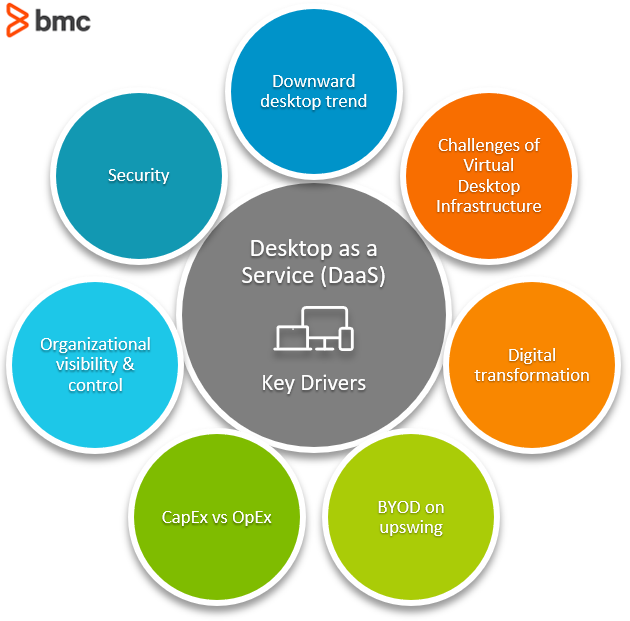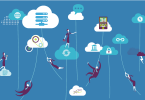Every employee needs a PC—a laptop or other device—that connects with backend data repositories, accesses apps, and communicates with users across the internet. Throughout the history of networked computing, enterprise IT has shifted to and fro between mainframe virtualized networking to desktop PCs and cloud computing to Virtual Desktop Infrastructure (VDI).
Today we rely less on legacy mainframe servers and in-house data centers for most business tasks. Instead, our devices simply operate as a dumb terminal to access services from the cloud.
More recently, the virtual desktop space has evolved into a subscription-based service where a third-party vendor is responsible for delivering VDI solutions—and enabling the financial and technical means necessary. This is called Desktop as a Service (DaaS).
What is desktop as a service?
Like any public cloud computing service, the DaaS is a multi-tenant solution. The vendor provides VDI instances that users within your organization can access over secure Web channels. The DaaS vendor also manages the associated computing resources, such as:
- Storage
- Operating system (OS) licensing
- Security
- Hardware
- Others
With desktop as a service, employers can enable a truly mobile workforce. DaaS means organizations can:
- Guarantee consistency
- Manage costs
DaaS vs VDI
DaaS differentiates from the VDI solution in that users only pay for the resources they consume, and the vendor invests the required financial and technical capital.
In essence, DaaS sounds like just another Software as a Service (SaaS) solution.
The shift to the cloud has enabled interesting parallels in user behavior. Especially during the pandemic-driven work-from-home culture, employees demand a consistent and streamlined user experience in accessing business apps and services from anywhere, anytime, using any device.
Cloud computing conceptually fulfills this demand and, together with the Bring Your Own Device (BYOD) movement, traditional VDI or corporate desktop solutions fail to keep pace.
Trends & drivers that support DaaS
In the context of DaaS supporting true mobile work, it’s important to understand the trends and external drivers that may contribute to DaaS growth in global enterprises. Here are key trends:

Downward desktop trend
For the last two decades, the desktop PC industry has trended downward. In fact, Gartner recently found that the PC market in 2020 recorded its fastest year-over-year growth since 2000. The percentage growth was 47% with 69.9 million PC units shipped in the first quarter of 2021.
VDI challenge
Traditional VDI requires extensive financial and technical resources in-house. VDI is complex and often, the per-user ROI on VDI instances remains less feasible for small and midsize businesses. For large enterprises, VDI delivery must also take the form of a cloud service, either internally through a private cloud or with an external public cloud vendor.
Further, in-house VDI solutions would eventually hit the wall when no more hardware resources and OS licenses are available to enroll new users.
For those that VDI remains a challenge or too complex, DaaS might be a better alternative.
Digital transformation
Organizations switching to a digital and mobile-first strategy—undergoing digital transformation—must eliminate dependence on specific devices and in-house data center resources.
Especially when digital transformation aims to empower and scale the user-base, DaaS is a simple and scalable solution.
BYOD gaining popularity
The global BYOD and Enterprise Mobility industry is expected to grow at a CAGR of 16.7% during the years 2020-2027, reaching the figure of $180 billion. Add to that: around 87% of global companies have required employees to work from home for some time. Plus, a limited supply of corporate devices as well as the global chip shortage have further encouraged employers to adopt BYOD policies.
For BYOD-driven remote offices, DaaS can be the perfect interface for employees to access business apps and information delivered from cloud environments.
CapEx vs OpEx (Capital vs Operating expenses)
The Total Cost of Ownership (TCO) argument favors both cloud and in-house data center environments—depending on the scale of usage. The economies of scale often favor the subscription-based cloud model for SMB firms, especially when scalability requirements are unpredictable and varied in nature.
(Learn more about capital vs operating expenses.)
Visibility & control
By enabling a mobile workforce and delivering a consistent OS interface that is centralized and managed collectively at the backend, organizations maintain visibility and control of their desktop environments. That means you can also perform key tasks remotely, including:
- Software updates
- Licensing
- App installations
Security
With DaaS, the security team can handle many capabilities on the backend, including:
- Identity and Access Management (IAM)
- Software patches
- Installations
- Potential risk mitigation
Since the devices you use to access DaaS are only used as dumb terminals, employers can extend remote work capabilities and operate a mobile workforce with maintaining low exposure to security risk.
Will DaaS replace physical PCs?
While DaaS aims to solve many challenges associated with remote working and supports the ongoing digital transformation trends, physical desktop PCs remain relevant.
Moderately powerful workstations will continue to attract the power user in engineering and IT whose work involves more than simply accessing the cloud CRM and analytics solutions. In such use cases, a hybrid VDI-DaaS solution can help achieve an optimal cost-benefit performance.
Related reading
- BMC IT Operations Blog
- BMC Multi-Cloud Blog
- Converged vs Hyperconverged Infrastructure: The Differences Between CI & HCI
- Cloud Growth, Trends & Outlook
These postings are my own and do not necessarily represent BMC's position, strategies, or opinion.
See an error or have a suggestion? Please let us know by emailing blogs@bmc.com.






